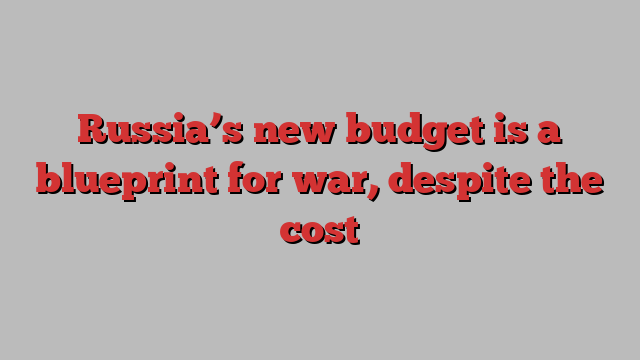
Stay informed with free updates
Simply sign up to the War in Ukraine myFT Digest — delivered directly to your inbox.
The writer is a fellow at the Carnegie Russia Eurasia Center in Berlin
As the Kremlin rolls out a new budget for 2025, gone are hopes that this year’s unprecedented levels of military spending represent a peak of what Vladimir Putin can afford to spend on his ugly war of conquest against Ukraine.
Contrary to global expectations — and even the Russian government’s own projections — the Kremlin now plans to increase defence spending by 22.6 per cent compared with this year, a staggering 58 per cent rise from the original budget drafted in late 2023. This signals that Putin’s ambitions in Ukraine remain as entrenched as ever. Far from scaling back, the Russian president appears willing to absorb rising costs in his fight, which he views as existential to his regime’s survival.
The numbers are stark: added together, defence and national security spending will now surpass 8 per cent of Russia’s GDP and account for 40 per cent of all federal expenditure, the highest levels since the collapse of the Soviet Union. Although projections for 2026 and 2027 suggest a slight reduction to 5.6 per cent and 5.1 per cent of GDP respectively, this does little to ease concerns. From a fiscal perspective, military expenditure seems like an obvious candidate for cuts. But in Putin’s Russia, the war drives the economy. Other key sectors — education, healthcare and even social policy — are seeing minimal growth or outright decline, despite Kremlin rhetoric about prioritising social welfare.
Russia is entering a period of military strategic reconstruction that could last up to eight years, according to my colleague Dara Massicot. With a steady stream of commodity revenues, a competent economic team and escalating repression at home, the Kremlin can continue funding its war effort for the foreseeable future.
However, the resources Putin can muster are not unlimited. By pouring more money into defence, the Kremlin is exacerbating existing economic imbalances. It is clear that Russian leadership prioritises military strength over long-term economic stability. The Kremlin’s logic is: “We’ll cross that bridge when we come to it.”
Two major constraints loom over Putin’s economic strategy: a shrinking workforce and the weight of international sanctions. With unemployment at a historic low of 2.4 per cent, Russia’s labour market is already struggling. The shortage of workers will undermine the military-industrial complex’s ability to boost production, despite recent efforts to expand capacity. While continued trade with countries such as China aids the Russian economy, sanctions have significantly restricted the Kremlin’s ability to modernise its military, squeezing access to essential components and creating bottlenecks in supply chains and financial transactions.
Putin faces an unsolvable trilemma of simultaneously maintaining a balanced financial system, meeting social obligations and sustaining defence spending at current levels.
The trade-offs are already apparent. As military expenditure rises, other areas of the budget are being squeezed, and this will only worsen as the war drags on. The main loser is the public sector — education, healthcare, science and utilities — which has been and will remain underfunded and underemployed.
Still, Putin’s adaptable economy can survive for several more years. This is an unpleasant truth for policymakers in Europe and the US. Instead of hoping that Russia’s economic combat power will soon be exhausted, the west must focus on a long-term strategy that will further constrain Putin’s war machine and boost Ukraine’s own economic resilience. With co-ordinated efforts from across the west — chiefly the increased enforcement of sanctions, resulting in ever-increasing transaction costs for Russia — the time when Putin will be forced to make tough choices can be brought forward.